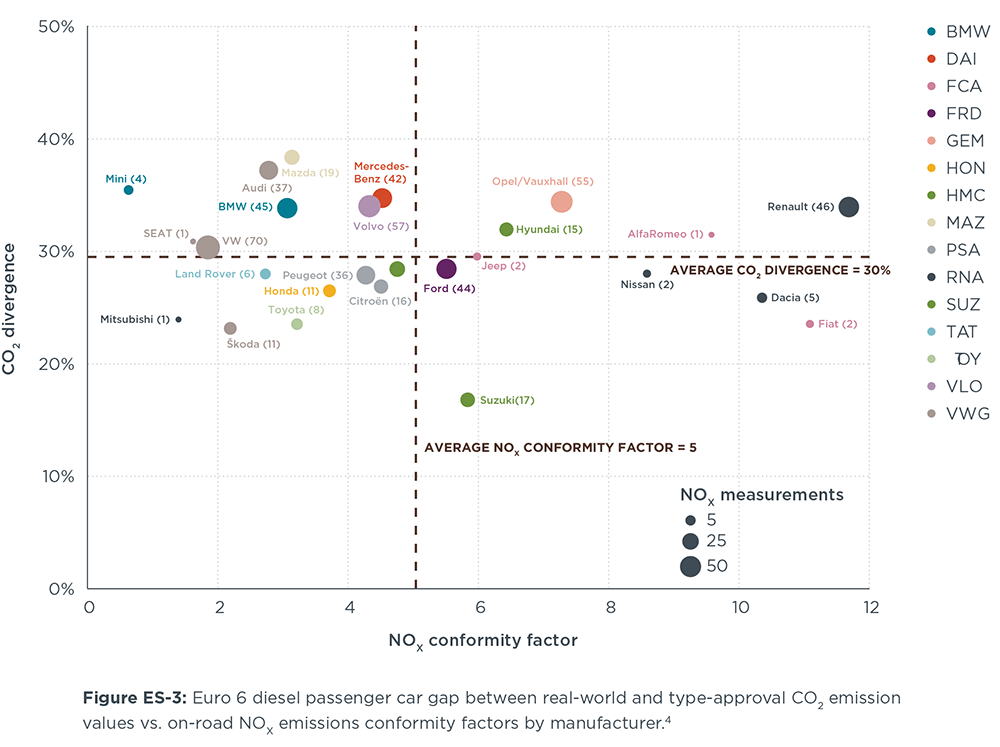In the aftermath of the Dieselgate scandal, government agencies across Europe began to systematically test diesel cars for their emission levels. A new study by the independent research organization International Council on Clean Transportation compiles the test results for 541 Euro 5 and Euro 6 diesel passenger cars. For Euro 6 vehicles, the average real-world level of nitrogen oxide (NOx) emissions is 4.5 times above the Euro 6 limit. Only 10% of Euro 6 cars outperform the Euro 6 limit, while the rest of vehicles exceed the Euro 6 standard by up to 12 times.
In September 2015, when the news broke about the illegal defeat device used by Volkswagen in the United States, no systematic overview of real-world NOx emission levels by vehicle manufacturer and model had ever been carried out in Europe. Over the ensuing two years, a number of government agencies across Europe began to systematically test diesel cars for their emission levels. ICCT researchers have now compiled the test results available so far. “For our study, we have collected and analyzed emission test results for 541 Euro 5 and Euro 6 diesel passenger cars, carried out amongst others by the British, Dutch, French, and German governments,” explains Dr. Peter Mock, Managing Director of ICCT in Europe, “This is the most comprehensive compilation of Euro 5 and Euro 6 diesel real-world NOx test results available.” The data represents 145 of the most popular European vehicle models, typically with several vehicles tested per model.
All emission measurements were conducted under real-world conditions, often following the Real Driving Emissions (RDE) testing procedure that came into force in September 2017. The majority of testing was carried out using portable emissions measurement system (PEMS) devices for recording emissions.
“The results confirm earlier findings but are now based on a very large number of individual vehicle tests and furthermore allow for conclusions about the performance of individual vehicle manufacturers,” says Dr. Peter Mock. For the Euro 5 diesel cars tested, the average conformity factor was 4.1, meaning that the actual emissions are more than 4 times the legal limit of 180 mg/km. For Euro 6 diesel cars, the average emission level was 4.5 times the the legal limit of 80 mg/km. The difference between individual vehicle models is particularly remarkable, with some Euro 6 diesel cars emitting less NOx than the limit while others exceed the regulatory limit by a factor of 12. Only 10% of tested Euro 6 vehicles would meet the Euro 6 limits on the road.
Under both Euro 5 and Euro 6, Opel and Renault-Nissan cars, particularly the Opel Insignia and Nissan Qashquai, recorded some of the highest NOx conformity factor readings, indicating the vehicles were the farthest out of compliance with standards. At the other end of the spectrum, BMW vehicles had some of the lowest NOx conformity factors. For Volkswagen, Euro 6 diesel cars had an average conformity factor lower than 2.
The ICCT analysis not only includes NOx testing results but also adds information on the real-world carbon dioxide (CO2) performance for each vehicle model. This information is derived from Spritmonitor (www.spritmonitor.de), a website that allows drivers to report their real-world fuel consumption figures. For the Euro 5 and Euro 6 vehicles included in the study, covering the model years 2011 to 2015, the average CO2 divergence was approximately 30%. The discrepancy among newer vehicles is even higher, with 2015 passenger cars on average emitting 40% more CO2 and consuming 40% more fuel than advertised.
The ICCT researchers emphasize that on-road emission tests, such as the ones carried out in the two years following Dieselgate, should be the beginning of a long-term monitoring program. Such a monitoring program should not only include NOx but also CO2 and other emissions, measured under real-world driving conditions. “Vehicles for testing should be independently sourced and financed, rather than being provided by manufacturers, and all test results should be made publicly available within a reasonable timeframe,” adds Dr. Peter Mock. If exceedances are found, recalls and penalties should be promptly imposed.



